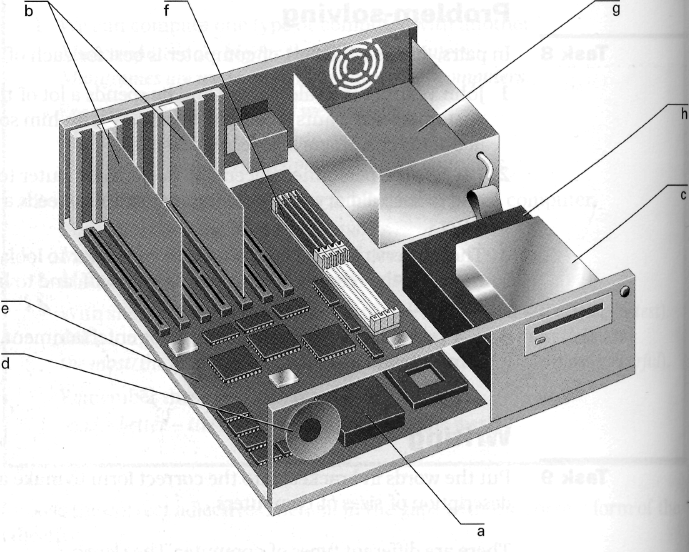
3. Parts of a Computer.
Objectives
By the end of this unit, students should be better at:
- matching pictures of components to their English names and functions
- listening for specific detail.
They should be able to:
- make simple instructions
- use sequence words.
They should know and be able to use these words and abbreviations:
byte, kilobyte, megabyte, gigabyte, megahertz, motherboard, port, RAM, ROM, cache memory, expansion card.
Tuning-in
Most computers consist of an electronic central processing unit (CPU) to which are attached different input devices, output devices, and storage devices. The main parts of a desktop computer are enclosed in a box known as the system unit. This contains an electronic board called the motherboard that holds and connects together the main electronic components. These are shown in the table below.
Processor controls the system and processes the data (microprocessor) ROM (Read stores the program instructions the computer needs to start up Only Memory) RAM (Random stores the data being processed Access Memory) Cache memory speeds up the processing |
The motherboard usually has empty electronic connectors, called expansion slots, into which additional electronic boards (sometimes called expansion cards) can be plugged. This allows extra electronic components to be added. Fоr example, more memory can be added by plugging memory boards (called SIMMS) into the memory slots. Sound facilities can be added by plugging a sound card into an expansion slot. This is one way of upgrading a computer. Another way is to replace the motherboard with a newer and better one. The system unit usually also contains a small speaker (or loudspeaker), the power supply, and some storage devices. These often include: a hard disk drive with a fixed disk that can store a very large amount of data; a floppy disk drive that uses removable floppy disks (diskettes); a CD-ROM drive that is used for reading CD-ROM disks (particularly in multimedia computers). Some other devices may be included in the system unit but most input and output devices are plugged into the back of the system unit using connectors known as ports.
Power is a function of both speed and capacity. The power of a computer depends on the combination of all the components. When buying a computer, you can often choose between different components. In particular, you can choose between different processor speeds, amounts of memory and hard disk sizes. Units of measurement commonly used in computing are shown below.
Unit Symbol Meaning Measurement Hertz Hz cycles per second frequency
Byte b space for one character, capacity (pronounced like bite) i.e. one letter, number, punctuation mark, symbol, or even a space |
Hertz are measured using the decimal (of tens or one-tenth) system but bytes are measured using the binary (of or involving a pair or pairs) system. The values of the unit prefixes vary in these two systems as shown in the table below.
Unit |
Symbol |
Decimal System |
Binary System |
kilo |
К |
103 = 1000 |
210=1024 |
mega |
M |
106= 1000000 |
220= 1048576 |
giga |
G |
109 = 1000000000 |
2зо = 1073741824 |
(MHz = megahertz, Kb = kilobytes, Mb = megabytes, Gb = gigabytes)
Do the task then check with the key...
Task 1 Look at the diagram to cover the vocabulary below.
Work in pairs. Study this diagram of the inside of a computer. Can you label these components? Compare your answers with other students in your class.

2 motherboard
3 memory chips
4 power supply
5 processor
6 speaker
7 expansion cards
8 floppy drive
